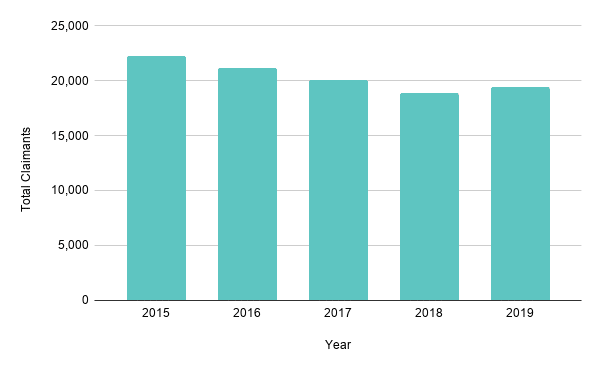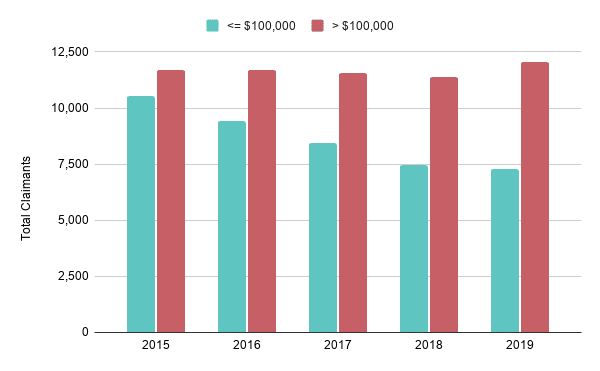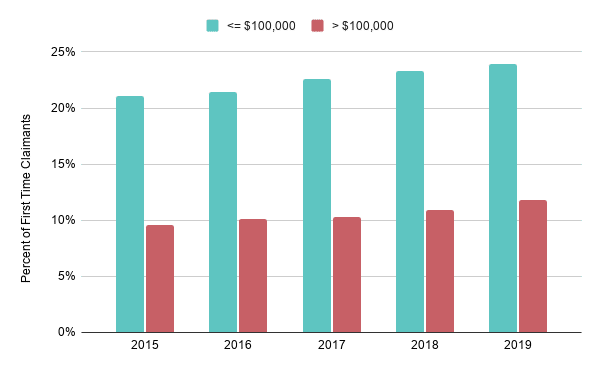Each year about 20,000 Canadian businesses file for Scientific Research and Experimental Development (SR&ED) tax credits. The data shows that the number of claimants over the past 3 years has been relatively stable. That said, one telling measure of Canada’s ability to promote innovation and nurture new businesses is the number of new SR&ED claimants every year.

The chart below reveals that while the number of SR&ED claims of more than $100k has remained stable over the past 5 years, the number of claims of less than $100k has dropped by more than 30%. The decline from 2018 to 2019 is not as significant as in prior years and therefore the hope is that this trend will not continue.

Why are fewer companies filing SR&ED claims under $100,000?
One clear reason for the drop could be Quebec’s policy change in December 2014. The change excluded the first $50,000 of SR&ED-eligible expenditures. Note that this did not affect the federal SR&ED refund which for most small CCPC’s is 35% of eligible expenses. Although Quebec could be the reason for the drop in 2016, it does not explain the continued decline in subsequent years. While the data from Statistics Canada is not available, the number of new small businesses founded every year has remained fairly constant for the past 8 years. In addition, there have been no other material changes in the provincial or federal SR&ED programs, except for Alberta, which eliminated their provincial refund on January 1st, 2020, and therefore is not part of this data set.
There are two other reasons which may explain the reduction in the number of SR&ED claims less than $100,000. One is the work the CRA has done in the First Time Claimant Advisory Service (FTCAS) to educate entrepreneurs. As a result, there are fewer claims but the claims that are submitted are more likely to be eligible.
The second reason could be that the effort to file a small claim has outweighed the potential benefit of the refund. The CRA hired more financial and technical reviewers and has conducted more and more reviews starting in 2015 to 2016. This was in an effort to ensure program compliance and reduce the number of claimants that were filing ineligible claims. Considering the drop in small claims, the CRA may have achieved their goals while also redefining the risk/reward formula for smaller companies filing for SR&ED.
The chart below shows the percentage of first-time claimants for claims above and below the $100,000 mark. Interestingly, both are growing with a 23% increase over five years for claims of more than $100,000 and a 14% increase for claims less than $100,000.

Looking at all the data together, the SR&ED program seems to be working as it should be for companies filing claims over $100,000. Every year there is an increasing number of first-time claimants which is a good indication that the program is successfully attracting new businesses. However, some companies are no longer claiming SR&ED expenditures (either due to acquisition, bankruptcy or ineligibility), and the total number of claimants is relatively constant.
For companies filing less than a $100,000 SR&ED claim, we see an increasing number of first-time claimants but the total number of claimants decreasing. The most likely interpretation of this is that those companies filing for the first time are less likely to file successful claims as the CRA is doing more reviews and weeding out ineligible claims. Therefore, these companies don’t claim SR&ED a second time until they are certain they have eligible R&D expenditures.
What do these numbers mean for the Canadian economy and the SR&ED program?
We would like to see the total number of claimants increase. Having small companies apply for the SR&ED program is an indicator of the strength of our entrepreneurial leadership. With larger companies applying, it shows the strength of our investment in R&D coupled with retaining ownership of Canadian companies. We have seen many instances where great Canadian technology companies are acquired by foreign entities. Oftentimes, and especially for US-headquartered companies, the benefits of filing for SR&ED are reduced, if not eliminated. By having a stronger SR&ED program we build stronger, more valuable companies that stay Canadian.
 About Garron Helman
About Garron Helman
Garron helps company founders grow their businesses by providing non-dilutive financing to hundreds of great Canadian startups. Garron is a recognized leader in SR&ED identification with expert knowledge in tax credit programs in Canada.
Contact Garron to learn more about the SR&ED program and how venture debt can help accelerate your business’s growth.




